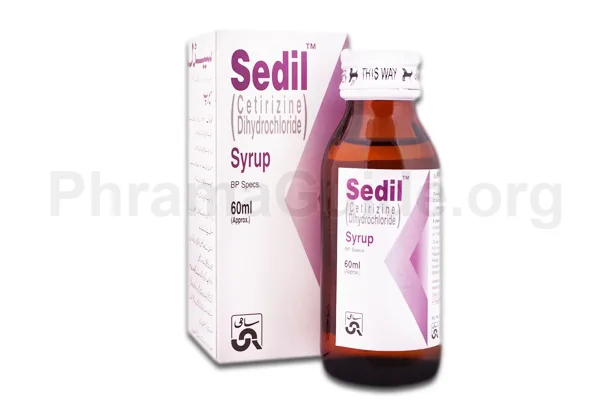Sedil syrup is an antihistamine medication primarily used to treat various allergic conditions. It is a second-generation antihistamine, which means it is less likely to cause drowsiness compared to first-generation antihistamines. That is why Sedil syrup can be used in pediatric patients. The following are some common and off-label uses of Sedil Syrup:
Common Uses of Sedil Syrup
- Allergic Rhinitis: Sedil syrup is often used to relieve symptoms of allergic rhinitis, which include sneezing, runny or itchy nose, itchy or watery eyes, and nasal congestion due to allergens such as pollen, dust mites, pet dander, and mold.
- Urticaria (Hives): Sedil syrup can provide relief from itching, redness, and swelling associated with urticaria, a skin condition characterized by raised, itchy welts.
- Allergic Conjunctivitis: Itchy, red, and watery eyes caused by allergic conjunctivitis can be alleviated by Sedil syrup.
- Allergies from Insect Bites/Stings: Sedil syrup may help reduce itching and inflammation resulting from allergic reactions to insect bites or stings.
- Other Allergic Skin Conditions: Sedil syrup might be used to manage itching and discomfort associated with various allergic skin conditions, such as eczema or contact dermatitis.
Off-label Uses of Sedil Syrup
- Eczema (Atopic Dermatitis): Sedil syrup may be used off-label to help manage itching and discomfort associated with atopic dermatitis (eczema), especially when itching is a prominent symptom.
- Pruritus (Itching): Sedil’s antihistamine properties could potentially provide relief from itching caused by various conditions, such as pruritus associated with liver disease or kidney disease.
- Cold Symptoms: While Sedil is not typically indicated for the common cold, it might be used off-label to alleviate symptoms such as a runny or congested nose.
- Motion Sickness: Sedil’s antihistamine effects may help reduce symptoms of motion sickness, such as nausea and dizziness.
- Allergic Reactions to Medications: Sedil may be used off-label to help manage allergic reactions to certain medications, under a healthcare professional’s guidance.
- Chronic Urticaria: Sedil is approved for acute urticaria (hives) but might be used off-label for chronic urticaria that doesn’t respond well to other treatments.
- Prevention of Allergic Reactions: In some cases, Sedil may be used off-label to prevent allergic reactions when exposure to allergens is anticipated, such as before visiting an environment with known allergens.

What is Sedil?
Sedil Syrup is one of the leading brands of Cetirizine in oral liquid form, manufactured and marketed by Sami Pharmaceuticals (Pvt) Ltd, Pakistan.
Sedil Alternatives : Other Cetirizine Brands
The following are some alternative brands of Sedil Syrup and their manufacturers.
- Rigix : AGP Pharma, Pakistan.
- Zyrtec : GlaxoSmithKline Pharmaceuticals Ltd (GSK).
- Gixer : Barrett Hodgson Pakistan (Pvt) Ltd.
- Baydal : Bayer Schering Pharmaceuticals.
- Incidal-Neo : Bayer Schering Pharmaceuticals.
- Gixer : Barrett Hodgson Pakistan (Pvt) Ltd.
- Cetrix : Saffron Pharmaceuticals, Pakistan.
- Cerzine : Pharmevo (Pvt) Ltd, Pakistan.
- Dicet : Sharooq Pharmaceuticals, Pakistan.
- Tarcit : Searl Pakistan (Pvt) Ltd.
- Arix : Tabros Pharma, Pakistan.
- Zanlan : Novartis, Pakistan.
- Arozine : Global Pharmaceuticals, Pakistan.
- Rex : Albro Pharma (Pakistan).
Sedil : Available Formulations and Strengths
Presently, Sedil is available in Syrup and Tablet forms.
Sedil Syrup: 5mg/5ml strength.
Sedil Tablet: 10mg strength.
Who Should Not Use Sedil?
Sedil is generally considered safe for most individuals when taken as directed by a healthcare professional or according to the product label. However, there are certain contraindications and precautions to be aware of.
- Hypersensitivity or Allergy: Do not use Sedil if you have a known hypersensitivity or allergy to Sedil or any of its components.
- Kidney Impairment: Sedil is primarily eliminated from the body through the kidneys. If you have severe kidney impairment, your doctor may need to adjust the dosage.
- Pregnancy and Breastfeeding: While Sedil is generally considered safe during pregnancy and breastfeeding, it’s important to consult a healthcare provider before using any medication during these periods.
- Elderly Patients: Elderly individuals may be more susceptible to certain side effects of Sedil, such as drowsiness or dizziness.
- Alcohol and Sedatives: Sedil may enhance the sedative effects of alcohol and other central nervous system depressants. Avoid excessive alcohol consumption while taking Sedil.
- Central Nervous System Disorders: Sedil may have mild sedative effects. If you have certain central nervous system disorders, such as epilepsy, consult a healthcare provider before using Sedil.
- Driving and Operating Machinery: Sedil can cause drowsiness in some individuals. If you experience drowsiness, avoid activities that require alertness, such as driving or operating heavy machinery.
- Medications with Similar Effects: Sedil may interact with other medications that have sedative effects or affect the central nervous system. Inform your healthcare provider about all medications you are taking.
- Underlying Health Conditions: Inform your healthcare provider about any existing medical conditions you have, especially if they may interact with Sedil or its effects.
Recommended Daily Dosage of Sedil Syrup
Sedil Syrup Dose for Adults and Children (12 years and older):
- 5 to 10 ml (approximately 1 to 2 teaspoons) once daily.
Sedil Syrup Dose for Children (6 to 11 years):
- 5 ml (approximately 1 teaspoon) once daily.
Sedil Syrup Dose for Children (2 to 5 years):
- 2.5 ml (approximately ½ teaspoon) once daily.
How Sedil Works?
Sedil is a second-generation antihistamine that primarily works by blocking the effects of histamine, a chemical released by the body in response to allergens. Histamine is responsible for many allergy symptoms, such as itching, sneezing, runny nose, and watery eyes. Sedil’s mode of action involves binding to histamine receptors and preventing histamine from exerting its effects.

Leave A Comment